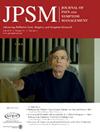生命末期谵妄的昼夜节律:两项随机对照试验的二次分析。
IF 3.5
2区 医学
Q2 CLINICAL NEUROLOGY
引用次数: 0
摘要
背景:临终谵妄中躁动的昼夜节律模式尚未得到充分研究和了解。目的:探讨急性姑息治疗病房收治的晚期癌症伴临终谵妄患者出现突破性躁动的时机。方法:这是对两项随机临床试验的二次分析,研究了劳拉西泮(MAD试验)和抗精神病药(CHAD试验)对临终谵妄的影响。在这项研究中,我们以8小时为间隔(早上7点到下午3点,晚上3点到11点,晚上11点到早上7点)检查烦躁的频率。突破性躁动的测量基于(1)对突破性躁动给予抢救药物(神经抑制剂或苯二氮卓类药物)和(2)Richmond激动镇静量表(RASS)评分≥+1(每2-4小时收集一次)。结果:本研究纳入128例患者(58例来自MAD试验,70例来自CHAD试验);平均年龄(SD) 64岁(12.5岁),女性57例(44.5%)。我们发现,在两项试验的单变量分析中,下午3点至11点与更多的抢救药物使用显著相关(MAD:估计:0.35,95% CI: 0.23-0.48, p)。结论:谵妄患者在下午3点至11点之间更不安。这种对“日落”的观察可以帮助临床医生更好地预测这种症状,安排监测和治疗,并教育患者和护理人员。本文章由计算机程序翻译,如有差异,请以英文原文为准。
Circadian Rhythm in End-Of-Life Delirium: A Secondary Analysis of Two Randomized Controlled Trials
Context
The circadian pattern of restlessness in end-of-life delirium is understudied and poorly understood.
Objective
To examine the timing of breakthrough restlessness in patients with advanced cancer and end-of-life delirium admitted to an acute palliative care unit.
Methods
This is a secondary analysis of two randomized clinical trials that examined the effect of lorazepam (MAD trial) and neuroleptics (CHAD trial) in end-of-life delirium. In this study we examined the frequency of restlessness in 8-hour intervals (7 AM–3 PM, 3–11 PM, 11 PM–7 AM). Breakthrough restlessness was measured based on 1) rescue medications (neuroleptics or benzodiazepines) administered for breakthrough restlessness and 2) a Richmond Agitation-Sedation Scale (RASS) score ≥+1 (collected every 2–4 hours).
Results
This study included 128 patients (58 from MAD trial, 70 from CHAD trial); the mean age (SD) was 64 (12.5), and 57 (44.5%) were women. We found that 3–11 PM was significantly associated with greater rescue medication use in univariate analysis for both trials (MAD: Estimate: 0.35, 95% CI: 0.23–0.48, P < 0.001; CHAD: Estimate: 0.1, 95% CI: 0.07–0.12, P < 0.001). This association remained significant in multivariate analysis for CHAD (Estimate: 0.1, 95% CI: 0.07–0.12, P < 0.001). About 3–11 PM was also associated with greater episodes of RASS ≥+1 in MAD in univariate and multivariate analysis (Estimate:0.31, 95 % CI: 0.21–0.42, P < 0.001).
Conclusion
Delirious patients were more restless between 3 PM and 11 PM. This observation of “sundowning” may help clinicians to better anticipate this symptom, schedule monitoring and treatments, and educate patients and caregivers.
求助全文
通过发布文献求助,成功后即可免费获取论文全文。
去求助
来源期刊
CiteScore
8.90
自引率
6.40%
发文量
821
审稿时长
26 days
期刊介绍:
The Journal of Pain and Symptom Management is an internationally respected, peer-reviewed journal and serves an interdisciplinary audience of professionals by providing a forum for the publication of the latest clinical research and best practices related to the relief of illness burden among patients afflicted with serious or life-threatening illness.

 求助内容:
求助内容: 应助结果提醒方式:
应助结果提醒方式:


